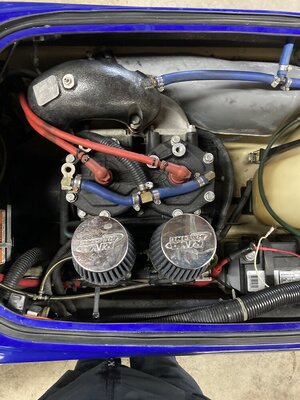I just picked up my second Superjet, my first Superjet with mods. It's got an R&D head, B Pipe (with single cooling), aftermarket stainless prop, ride plate, etc. As I am from Michigan, I plan on doing "surf" riding on Lake Michigan, which lead me to question the aftermarket air filters it has. A previous owner put Riva Racing air filters on the carbs, without the waterproof mesh that goes over to keep water out. It looks like the ski was originally built as a rec/mild buoy racer, so the odds of it being upside down are lower than that in wave riding. I was looking for a second opinion on whether to keep the aftermarket air filters and buy the mesh coverings that supposedly keeps water out, or just switch back to the stock flame arrestor. I understand that there is still a chance of water getting in the stock air box, however it seems lower than that of air filters based off of the design.
Now onto the cooling, I've done some research on single cooling for a b pipe, and found some diagrams of it, and my cooling routing does not seem to match any that I have seen so far. I rode the ski a few days ago on a nicer day (for Michigan at this time- 40 degree air, ~40 degree water) for about 10 minutes just to shake down the ski, and make sure there were not any huge issues that needed to be addressed this winter. I never really rode it hard, as I was slightly paranoid about a cold seize, and colder air resulting in a leaner mixture, but got it to as high of an operating temperature as it would achieve with around 1/4-1/2 throttle maximum. Based off the temperature of stream coming out pisser, the water was warm, but not normal operating temperature as to be expected without restricting flow for cold water temperatures. From a glance, it looks like the water goes from the intake on the pump to the exhaust manifold(only one fitting-not set up for dual cooling), then from the bottom of the head pipe to the head, but the weird thing is there is a T fitting on the feed from the head pipe to both fittings on the head, then a line runs from the top of the head pipe with a T fitting to the end of the expansion chamber and the pisser. Based off of diagrams I've found from other posts on this forum it looks like I should run a line from the forwardmost fitting on the head to the top of the head pipe, then run a line from the bottom of the head pipe to a T fitting that splits to the pisser and end of the expansion chamber. I am wondering if you all think I should change my cooling routing, wait to see if it runs hot in normal operating conditions, or if my current cooling routing is fine. Below is an attachment of my engine bay and current routing.
Any input on either of these topics would be greatly appreciated. Thanks in advance!
Now onto the cooling, I've done some research on single cooling for a b pipe, and found some diagrams of it, and my cooling routing does not seem to match any that I have seen so far. I rode the ski a few days ago on a nicer day (for Michigan at this time- 40 degree air, ~40 degree water) for about 10 minutes just to shake down the ski, and make sure there were not any huge issues that needed to be addressed this winter. I never really rode it hard, as I was slightly paranoid about a cold seize, and colder air resulting in a leaner mixture, but got it to as high of an operating temperature as it would achieve with around 1/4-1/2 throttle maximum. Based off the temperature of stream coming out pisser, the water was warm, but not normal operating temperature as to be expected without restricting flow for cold water temperatures. From a glance, it looks like the water goes from the intake on the pump to the exhaust manifold(only one fitting-not set up for dual cooling), then from the bottom of the head pipe to the head, but the weird thing is there is a T fitting on the feed from the head pipe to both fittings on the head, then a line runs from the top of the head pipe with a T fitting to the end of the expansion chamber and the pisser. Based off of diagrams I've found from other posts on this forum it looks like I should run a line from the forwardmost fitting on the head to the top of the head pipe, then run a line from the bottom of the head pipe to a T fitting that splits to the pisser and end of the expansion chamber. I am wondering if you all think I should change my cooling routing, wait to see if it runs hot in normal operating conditions, or if my current cooling routing is fine. Below is an attachment of my engine bay and current routing.
Any input on either of these topics would be greatly appreciated. Thanks in advance!

